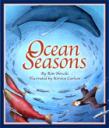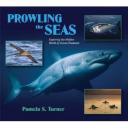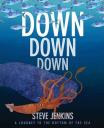The resources listed below are great to use in a 5th grade classroom for a unit on ecological characteristics of the ocean (VA Science SOL 5.6). You will find appropriate children's literature related to the ocean environment, websites for students to explore as well as websites for teachers and parents to supplement teaching about ocean ecology.
Recommended children's books:
Ocean Seasons by Ron Hirschi, Illustrated by Kirsten Carlson
This beautifully illustrated book focuses on the seasonal changes in marine life in the Pacific Ocean. The back of the book includes food web cards on each of the plants and animals mentioned throughout the book, serving as a great resource for teaching about ocean food webs and predator and prey relationships. These cards and additional resources for teaching with this book can be downloaded from the Ocean Seasons homepage.
Prowling the Seas: Exploring the Hidden World of Ocean Predators by Pamela S. Turner
This book presents research done by the Tagging of Pacific Predators (TOPP) Project, an organization created in 2000 by a group of scientists to study ocean predators and find ways to save them. The book focuses on four species studies by the TOPP project: loggerhead turtles, great white sharks, bluefin tuna, and sooty shearwater seabirds. Click here for more information on the author, Pamela S. Turner, as well as video clips on the TOPP project.
The Magic School Bus On the Ocean Floor by Joanna Cole, Illustrated by Bruce Degen
This book from the popular Magic School Bus series is filled with a wealth of information on the ocean and the creatures that live in it. Mrs. Frizzle and her class explore the various levels of the ocean floor and the different plant and animal life first hand as their school bus transforms into a submarine. The illustrations are filled with facts and labeled wildlife, providing great information in an entertaining and exciting fashion.
Down Down Down: A Journey to the Bottom of the Sea by Steve Jenkins
Caldecott honoree Steve Jenkins uses his beautiful paper collage illustrations to provide a top to bottom look at the ocean, from surface to the sea floor. Jenkins does a great job of explaining the many ocean ecosystems with kid-friendly text and labeled illustrations to help the reader identify the different forms of marine life. The back of the book contains more information about the animals in the book including diagrams to show the size of each of the creatures compared to an adult human’s body or hand.
Eye Wonder: Ocean by Samantha Gray
This book from the Eye Wonder series focuses on the different plant and animal life in the ocean. Beautiful photographs and information on various marine life is presented in an way that is appealing and easy to understand. A glossary of important ocean vocabulary and an animal alphabet is included in the back of the book for quick reference.
Websites for students:
OLogy: The Museum’s Science Website for Kids – This site is a great way for students to learn more about marine biology. It includes online games, directions for hands-on experiments, and much more!
Ocean Life & Ecosystems: Ocean Portal by the Smithsonian Institute – This site contains feature stories on various ocean life and ecosystems such as the great white shark and coral reefs in addition to an “Encylopedia of Life” which specific information on a wide variety of marine plants and animals.
Gould League: Food Webs – This website is a great way for students to explore the plants and animals that make up the marine food chain, from the producers to the herbivores to the carnivores.
Jean-Michel Cousteau: Ocean Adventures – This site provides several interactive web games for kids to further examine marine life and the role certain species play in the ocean ecosystem.
National Geographic: Great Barrier Reef – This site provides students the opportunity to explore the virtual word of Australia’s Great Barrier Reef.
Additional Resources for Teachers and Parents:
Ocean Planet: Interdisciplinary Marine Science Activities – This site from the Smithsonian contains ideas for lesson plans on a variety of ocean topics including “Sea Connections,” which looks at plants and animals that live in different marine ecosystems.
Scholastic Explorers: Ocean Life – This Scholastic site provides detailed instruction and resources for planning lessons on the impact of human activities on sea turtles of Costa Rica and dolphins in New Zealand.
SeaWorld: Just for Teachers – This is a great site with a wealth of materials and resources for teachers on various marine life including sharks, whales, seals, penguins and endangered species.
Treasures@Sea: Exploring the Ocean through Literature – This website includes a variety of book, writing, art and other interactive activities relating to the study of oceans.




